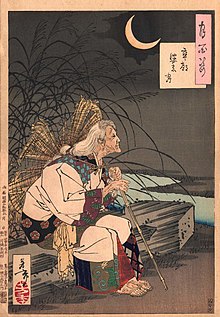Ono no Komachi

Ono no Komachi (小野 小町 approximate dates 825–900 A.D.) was a famous Japanese Waka poet, one of the Rokkasen—Six best Waka poets, in the early Heian period. She was noted as a rare beauty; Komachi is a symbol of a beautiful woman in Japan.
Life and legends
The place of Komachi's birth and death is uncertain. According to one tradition, she was born in what is now Akita Prefecture, daughter of Yoshisada, "Lord of Dewa"[1]. Her social status is also uncertain. She may have been a low-ranking consort or a lady-in-waiting of an emperor, possibly Emperor Nimmyō (r. 833-850).
As a poet, Komachi specialized in erotic love themes, expressed in complex poems.[2] Most of her waka are about anxiety, solitude or passionate love. She is the only female poet referred to in the preface of the Kokinshu, which describes her style as "containing naivity in old style but also delicacy".
There are legends about Komachi in love. The most famous is a story about her relationship with Fukakusa no Shosho, a high-ranking courtier. Komachi promised that if he visited her continuously for a hundred nights, then she would become his lover. Fukakusa no Shosho visited her every night, but failed once towards the end. Despairing, he fell ill and subsequently died. When Komachi learned of his death she was overcome with sadness.

Legacy
Komachi sometimes features in later period literature, including three[1] Noh plays, Sotoba Komachi and Komachi at Sekidera. These works tend to focus on her talent for waka and her love affairs and the vanity of a life spent indulging in romantic liaisons. Komachi's old age is also frequently protrayed: when she has lost her beauty, has been abandoned by her former lovers, and now regrets her life, wandering around as a lonely beggar woman[1]. This is a fictional description influenced by Buddhist thought and there may be no factual resemblance between this portrait and the historical reality.
In honor of her, the Akita Shinkansen is nicknamed Komachi. Also, a variety of rice, Akita Komachi, bears her name. One of her 31-syllable poems was chosen by Fujiwara no Teika as an entry in the very popular anthology Hyakunin Isshu.
References
- ^ a b c pg 141 of Woman poets of Japan, 1977, Kenneth Rexroth, Ikuko Atsumi, ISBN 0-8112-0820-6; previously published as The Burning Heart by The Seabury Press.
- ^ "Her beauty may be legendary but her rank as one of the greatest erotic poets in any language is not. Her poems begin the extreme verbal complexity which distinguishes the poetry of the Kokinshu Anthology from the presentational immediacy of the Manyoshu. pg 141 of Woman poets of Japan, 1977, Kenneth Rexroth, Ikuko Atsumi, ISBN 0-8112-0820-6; previously published as The Burning Heart by The Seabury Press.
- Hirshfield, Jane, and Mariko Aratani, translators,The Ink Dark Moon: Love Poems by Ono no Komachi and Izumi Shikibu, Women of the Ancient Court of Japan, New York, Vintage Books, 1990
